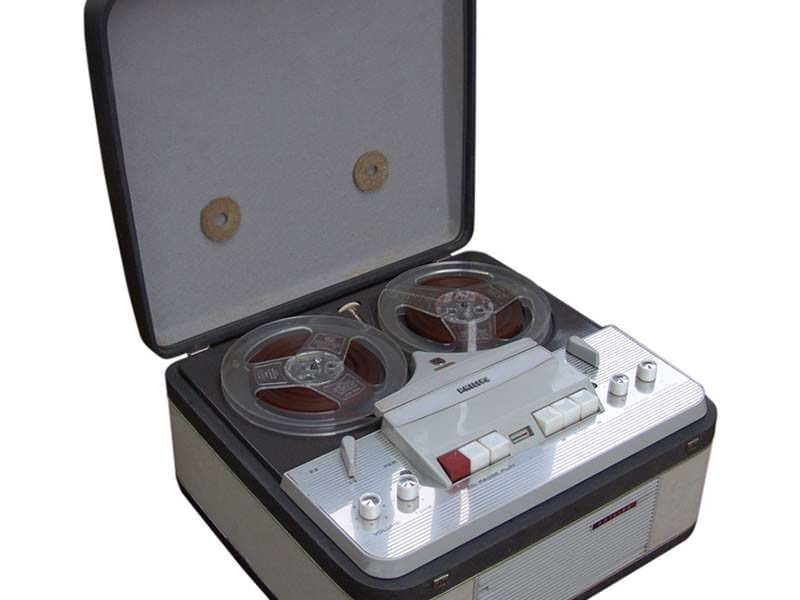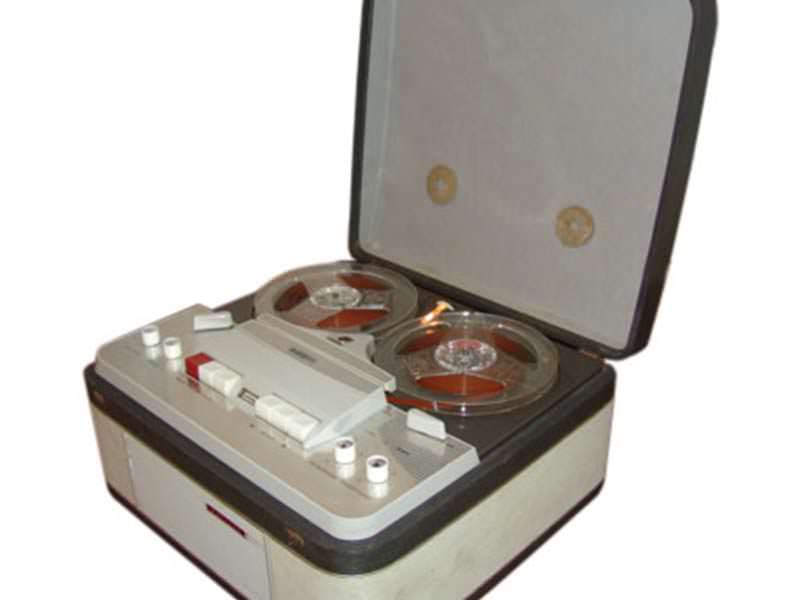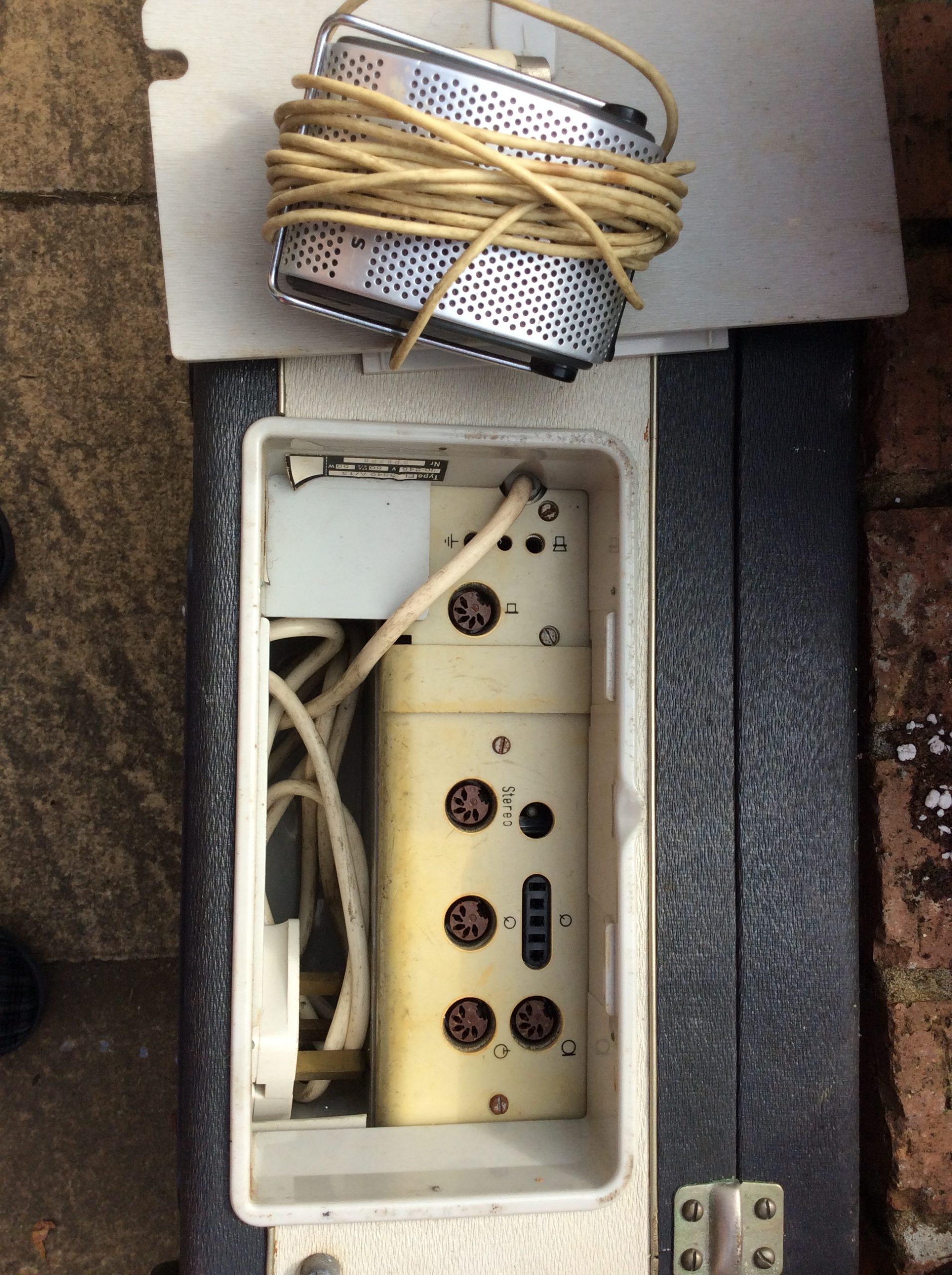Technical Details
Brand: Philips
Model:EL 3549
Category:Vintage
Application:Consumer
Electronics:Solid State
Equalization:NAB
Country of Manufacture:Netherlands
Release dates:1963 - 1966
Tracks:1/4 Rec/PB
Speeds: 1 7/8, 3 3/4, 7 1/2, 15
Max Reel Size("): 7"
Number of heads: 2
Dimension: 16½ x 15½ x 8¼" (419 x 394 x 210 mm)
Head Composition: Permalloy
Head Configuration: Mono - Full Track
Voltage(s): 220-240v
Outputs: RCA
Frequency Response:(all 3 dB): 7½ ips: 60 to 16kHz
Wow and Flutter:0.6% peak to peak
Signal-to-Noise Ratio:better than 40 dB
Sound quality rating:5 / 10
Long-term reliability rating: 5/ 10
Weight: 27 lbs (12.3 kg)
Additional Details
Description
The trend in Philips towards all-transistor mains tape recorders in their higher priced models was
extended with the introduction of the quarter-track EL3549, the successor to the EL3542.
It was a mid-priced, four speed machine (7½, 3¾, 1 7/8 & 15/16 ips) with a moving coil recording
level meter replacing the magic eye indicator and a four-digit tape position counter.
A single internal 7″ x 5″ elliptical speaker was powered by a 2½ watt all-transistorized amplifier, and by using an external stereo amp/speaker system, stereo playback was possible.
Additional Info
By H. Burrell Hodden, January 1964
THE Philips EL3549 is a portable, mains-operated tape recorder, with fully transistorised amplifiers. It operates on the four-track system, and has four speeds, 7½, 3¾, 1 and 15/16 ips. A track selector gives the choice of tracks 1 or 4, 2 or 3, or ” parallel,” giving the output of the two “forward going” tracks added together. The machine is suitable for long play or double play tape on any sized reel from three to seven inches in diameter, and the maximum playing time is eight hours per track.
The fast rewind time was three minutes for a seven-inch reel of long play tape. Automatic stop facilities of the foil-operated type are provided, and these operate in all running conditions. Input mixing facilities for microphone and radio/gram are provided, and the equipment can be used as an amplifier for microphone or record player if desired.
All the controls of the EL3549 are situated on one easily operated panel on the top of the machine. The speed selection control also operates the ” on/off” switch, so that the machine cannot be easily left with the idler wheels engaged. The controls for setting the tape in motion are of the ” piano key ” type. There are six of these, three on each side of the recording level meter. The first of the keys, from left to right, is the red coloured record control, which has to be pressed at the same time as the third key, the ” play” key, in order to make a recording. The second key, in between these two, is the pause control. The remaining three keys control fast rewind, stop, and fast-forward respectively. There are four other controls: on the left of the panel is the playback volume control, which also varies the loudspeaker monitor level on record, and this is accompanied by the playback tone control. On the right-hand side of the panel are the microphone and radio/gram record level controls. A digital type tape position indicator is placed between the tape reels, and has a magnifier in front of the scale, a very useful feature.
A storage compartment at the rear of the machine is large enough to carry the mains lead, microphone, and radio input lead, and also contains all the input and output sockets. Seven of these, of the now standard Continental type, are incorporated. To take the input sockets first: two alternative sockets are available for gramophone pickup connection, one for the flat Continental plug and the other for the round DIN plug. The microphone plug is also of the DIN type, and so is the ” diode” input, which gives record and playback connections for receivers and amplifiers fitted with the necessary socket connections. The playback output from this socket is at a fixed level, and must be controlled on the external equipment. The record input is controlled by the radio/gram level control. The input impedances are: ” diode ” 0.02 megohm, at a level of 3 mV; record player 0.5 megohm at a level of 150mV; and microphone 1,000 ohms, at a level of 1 mV. In addition to the diode output, three other output sockets are provided.
The first of these is a ” banana” plug type extension loudspeaker socket; inserting the plug mutes the internal loudspeaker. The output impedance at this socket is 3-7 ohms. The other two sockets are of the DIN type, one being a socket for headphone monitoring available as an accessory, and the other giving a direct connection to the two halves of the replay head. This socket is labelled stereo,” but a word of warning must be inserted here, since the level at this socket is so low that a preamplifier, also available as an accessory, must be used. This head and pre-amplifier can also be utilised for Duoplay and Multiplay purposes.
A further socket is provided for an accessory foot-operated switch, useful to control the machine when it is being used for dictation purposes.
As might be expected, a machine with such a formidable specification is of necessity somewhat large, the dimensions are 16½ x 15½ x 8¼ inches. Due to the transistorised electronics, however, the weight of the machine is not excessive, only 28 Ibs. The case is finished in an attractive two-tone grey, very pleasing to the eye.
The machine was given the usual practical and technical tests. In all cases it performed exceptionally well. Even at 1 ips some very good music recordings were made, and the quality of reproduction at 7½ ips left very little to be desired. The quality of speech reproduction at the extremely slow speed of 15/16 ips was perfectly adequate for dictation purposes. The overall frequency response from record input to replay output at the four speeds is shown on the accompanying diagram, and it can be seen that the maker’s specification was met in all cases. The signal-to-noise ratio was 43 dB. No wow and flutter figures are specified, but the performance on music at even the slower speeds indicates that this is satisfactory.
A moving coil cardioid microphone is provided, which though good of its type, does not really do the machine justice, especially at 7½ ips. A word of praise must be reserved for the instruction book, which is exceptionally clearly written, and well illustrated with step by step photographs.
All in all, this machine can be thoroughly recommended as a good buy at £65 2s.
Rewind speed: 3 minutes for 7″ LP tape / Audio output power: 2.5 watts / Inputs: diode – 3mV / 20Kohm. phono – 150m / 500K. microphone – 1mV / 1K / Outputs: ext speaker – 3 to 7 ohms. headphones, stereo output and diode / Speaker(s): single internal 7″ x 5″ elliptical / quarter-track mono, stereo playback with external amp





